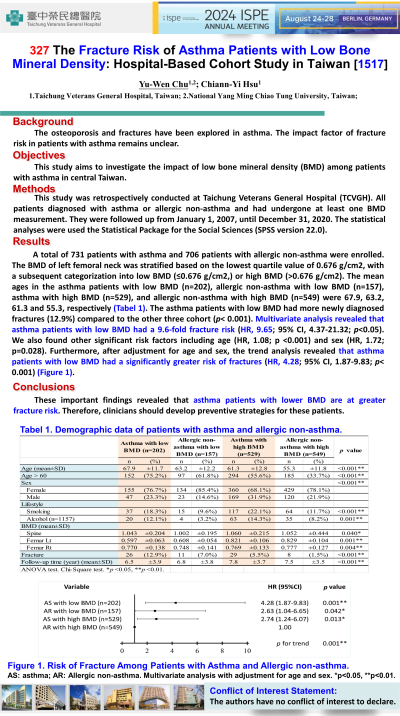Respiratory conditions and treatments
Session: Poster Session C
(327) The Fracture Risk of Asthma Patients with Low Bone Mineral Density: Hospital-Based Cohort Study in Taiwan
Wednesday, August 28, 2024
8:00 AM - 1:30 PM CEST
Location: Convention Hall II

.jpg)
Yu-Wen Chu, PhD (he/him/his)
Chief
Taichung Veterans General Hospital
Taichung, Taiwan (Republic of China)
Presenting Author(s)
Background: The osteoporosis and fractures have been explored in asthma. The impact factor of fracture risk in patients with asthma remains unclear.
Objectives: This study aims to investigate the impact of low bone mineral density (BMD) among patients with asthma in central Taiwan.
Methods: This study was retrospectively conducted at Taichung Veterans General Hospital (TCVGH). All patients were diagnosed with asthma or allergic non-asthma and had undergone at least one BMD measurement. They were followed up from January 1, 2007, until December 31, 2020. The statistical analyses used the Statistical Package for the Social Sciences (SPSS version 22.0).
Results: A total of 731 patients with asthma and 706 patients with allergic non-asthma were enrolled. The BMD of the left femoral neck was stratified based on the lowest quartile value of 0.676 g/cm2, with a subsequent categorization into low BMD (≤0.676 g/cm2,) or high BMD (>0.676 g/cm2). The mean ages in the asthma patients with low BMD (n=202), allergic non-asthma with low BMD (n=157), asthma with high BMD (n=529), and allergic non-asthma with high BMD (n=549) were 67.9, 63.2, 61.3 and 55.3, respectively. The asthma patients with low BMD had more newly diagnosed fractures (12.9%) compared to the other three cohorts (p < 0.001). Multivariate analysis revealed that asthma patients with low BMD had a 9.6-fold fracture risk (HR, 9.65; 95% CI, 4.37-21.32; p < 0.05). We also found other significant risk factors including age (HR, 1.08; p < 0.001) and sex (HR, 1.72; p=0.028). Furthermore, after adjustment for age and sex, the trend analysis revealed that asthma patients with low BMD had a significantly greater risk of fractures (HR, 4.28; 95% CI, 1.87-9.83; p< 0.001).
Conclusions: In conclusion, the important findings revealed that asthma patients with lower BMD are at greater fracture risk. Therefore, clinicians should develop preventive strategies for these patients.
Objectives: This study aims to investigate the impact of low bone mineral density (BMD) among patients with asthma in central Taiwan.
Methods: This study was retrospectively conducted at Taichung Veterans General Hospital (TCVGH). All patients were diagnosed with asthma or allergic non-asthma and had undergone at least one BMD measurement. They were followed up from January 1, 2007, until December 31, 2020. The statistical analyses used the Statistical Package for the Social Sciences (SPSS version 22.0).
Results: A total of 731 patients with asthma and 706 patients with allergic non-asthma were enrolled. The BMD of the left femoral neck was stratified based on the lowest quartile value of 0.676 g/cm2, with a subsequent categorization into low BMD (≤0.676 g/cm2,) or high BMD (>0.676 g/cm2). The mean ages in the asthma patients with low BMD (n=202), allergic non-asthma with low BMD (n=157), asthma with high BMD (n=529), and allergic non-asthma with high BMD (n=549) were 67.9, 63.2, 61.3 and 55.3, respectively. The asthma patients with low BMD had more newly diagnosed fractures (12.9%) compared to the other three cohorts (p < 0.001). Multivariate analysis revealed that asthma patients with low BMD had a 9.6-fold fracture risk (HR, 9.65; 95% CI, 4.37-21.32; p < 0.05). We also found other significant risk factors including age (HR, 1.08; p < 0.001) and sex (HR, 1.72; p=0.028). Furthermore, after adjustment for age and sex, the trend analysis revealed that asthma patients with low BMD had a significantly greater risk of fractures (HR, 4.28; 95% CI, 1.87-9.83; p< 0.001).
Conclusions: In conclusion, the important findings revealed that asthma patients with lower BMD are at greater fracture risk. Therefore, clinicians should develop preventive strategies for these patients.
